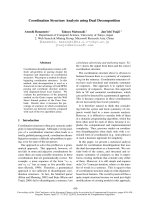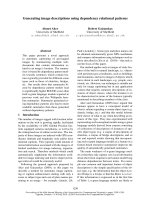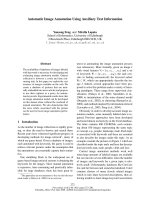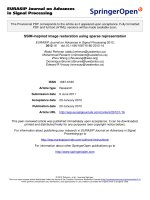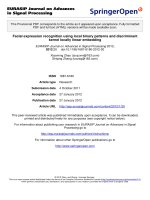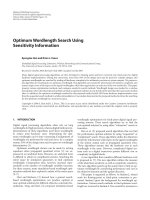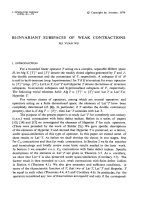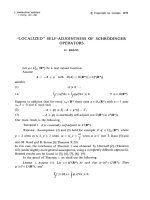Báo cáo toán học: " SSIM-inspired image restoration using sparse representation" docx
Bạn đang xem bản rút gọn của tài liệu. Xem và tải ngay bản đầy đủ của tài liệu tại đây (1.4 MB, 34 trang )
This Provisional PDF corresponds to the article as it appeared upon acceptance. Fully formatted
PDF and full text (HTML) versions will be made available soon.
SSIM-inspired image restoration using sparse representation
EURASIP Journal on Advances in Signal Processing 2012,
2012:16 doi:10.1186/1687-6180-2012-16
Abdul Rehman ()
Mohammad Rostami ()
Zhou Wang ()
Dominique Brunet ()
Edward R Vrscay ()
ISSN 1687-6180
Article type Research
Submission date 6 June 2011
Acceptance date 20 January 2012
Publication date 20 January 2012
Article URL />This peer-reviewed article was published immediately upon acceptance. It can be downloaded,
printed and distributed freely for any purposes (see copyright notice below).
For information about publishing your research in EURASIP Journal on Advances in Signal
Processing go to
/>For information about other SpringerOpen publications go to
EURASIP Journal on Advances
in Signal Processing
© 2012 Rehman et al. ; licensee Springer.
This is an open access article distributed under the terms of the Creative Commons Attribution License ( />which permits unrestricted use, distribution, and reproduction in any medium, provided the original work is properly cited.
SSIM-inspired image restoration using sparse rep-
resentation
Abdul Rehman
∗1
, Mohammad Rostami
1
, Zhou Wang
1
, Dominique Brunet
2
and
Edward R Vrscay
2
1
Department of Electrical and Computer Engineering, University of Waterloo, Waterlo o, ON, N2L 3G1 Canada
2
Department of Applied Mathematics, University of Waterloo, Waterloo, ON, N2L 3G1 Canada
∗
Corresponding author: ab dul.rehman@uwaterlo o.ca
Email addresses:
MR:
ZW:
DB:
ERV:
1
Abstract
Recently, sparse representation based methods have proven to be successful towards solving
image restoration problems. The objective of these methods is to use sparsity prior of the underly-
ing signal in terms of some dictionary and achieve optimal performance in terms of mean-squared
error, a metric that has been widely criticized in the literature due to its poor performance as
a visual quality predictor. In this work, we make one of the first attempts to employ struc-
tural similarity (SSIM) index, a more accurate perceptual image measure, by incorporating it
into the framework of sparse signal representation and approximation. Specifically, the proposed
optimization problem solves for coefficients with minimum L
0
norm and maximum SSIM index
value. Furthermore, a gradient descent algorithm is developed to achieve SSIM-optimal compro-
mise in combining the input and sparse dictionary reconstructed images. We demonstrate the
performance of the proposed method by using image denoising and super-resolution methods as
examples. Our experimental results show that the proposed SSIM-based sparse representation
algorithm achieves better SSIM performance and better visual quality than the corresponding
least square-based method.
1 Introduction
In many signal processing problems, mean squared error (MSE) has been the preferred choice
as the optimization criterion due to its ease of use and popularity, irrespective of the nature
of signals involved in the problem. The story is not different for image restoration tasks.
Algorithms are developed and optimized to generate the output image that has minimum
MSE with respect to the target image [1–6]. However, MSE is not the best choice when
it comes to image quality assessment (IQA) and signal approximation tasks [7]. In order
to achieve better visual performance, it is desired to modify the optimization criterion to
the one that can predict visual quality more accurately. SSIM has been quite successful
2
in achieving superior IQA performance [8]. Figure 1 demonstrates the difference between
the performance of SSIM and absolute error (the bases for L
p
, MSE, PSNR, etc.). Figure
1c shows the quality map of the image 1b with reference to 1a, obtained by calculating the
absolute pixel-by-pixel error, which forms the basis of MSE calculation for quality evaluation.
Figure 1d shows the corresponding SSIM quality map which is used to calculate the SSIM
index of the whole image. It is quite evident from the maps that SSIM performs a better job
in predicting perceived image quality. Specifically, the absolute error map is uniform over
space, but the texture regions in the noisy image appear to be much less noisier than the
smooth regions. Clearly, the SSIM map is more consistent with such observations.
The SSIM index and its extensions have found a wide variety of applications, ranging from
image/video coding i.e., H.264 video coding standard implementation [9], image classification
[10], restoration and fusion [11], to watermarking, denoising and biometrics (see [7] for a
complete list of references). In most existing works, however, SSIM has been used for quality
evaluation and algorithm comparison purposes only. SSIM possesses a number of desirable
mathematical properties, making it easier to be employed in optimization tasks than other
state-of-the-art perceptual IQA measures [12]. But, much less has been done on using SSIM
as an optimization criterion in the design and optimization of image processing algorithms
and systems [13–19].
Image restoration problems are of particular interest to image processing researchers,
not only for their practical value, but also because they provide an excellent test bed for
image modeling, representation and estimation theories. When addressing general image
restoration problems with the help of Bayesian approach, an image prior mo del is required.
Traditionally, the problem of determining suitable image priors has been based on a close
observation of natural images. This leads to simplifying assumptions such as spatial smooth-
ness, low/max-entropy or sparsity in some basis set. Recently, a new approach has been
developed for learning the prior based on sparse representations. A dictionary is learned
either from the corrupted image or a high-quality set of images with the assumption that
it can sparsely represent any natural image. Thus, this learned dictionary encapsulates
the prior information about the set of natural images. Such methods have proven to be
quite successful in performing image restoration tasks such as image denoising [3] and image
3
super-resolution [5, 20]. More specifically, an image is divided into overlapping blocks with
the help of a sliding window and subsequently each block is sparsely coded with the help
of dictionary. The dictionary, ideally, models the prior of natural images and is therefore
free from all kinds of distortions. As a result the reconstructed blocks, obtained by linear
combination of the atoms of dictionary, are distortion free. Finally, the blocks are put back
into their places and combined together in light of a global constraint for which a minimum
MSE solution is reached. The accumulation of many blocks at each pixel location might
affect the sharpness of the image. Therefore, the distorted image must be considered as well
in order to reach the b est compromise between sharpness and admissible distortions.
Since MSE is employed as the optimization criterion, the resulting output image might
not have the best perceptual quality. This motivated us to replace the role of MSE with
SSIM in the framework. The solution of this novel optimization problem is not trivial because
SSIM is non-convex in nature. There are two key problems that have to be resolved before
effective SSIM-based optimization can be performed. First, how to optimally decompose an
image as a linear combination of basis functions in maximal SSIM, as opposed to minimal
MSE sense. Second, how to estimate the best compromise between the distorted and sparse
dictionary reconstructed images for maximal SSIM. In this article, we provide solutions
to these problems and use image denoising and image super-resolution as applications to
demonstrate the proposed framework for image restoration problems.
We formulate the problem in Section 2.1 and provide our solutions to issues discussed
above in Sections 2.2 and 2.3. Section 3.1 describes our approach to denoise the images.
The proposed method for image super-resolution is described in Section 3.2 and finally we
conclude in Section 4.
2 The proposed method
In this section we will incorp orate SSIM as our quality measure, particularly for sparse
representation. In contrast to what we may expect, it is shown that sparse representation in
minimal L
2
norm sense can be easily converted to maximal SSIM sense. We will also use a
gradient descend approach to solve a global optimization problem in maximal SSIM sense.
4
Our framework can be applied to a wide class of problems dealing with sparse representation
to improve visual quality.
2.1 Image restoration from sparsity
The classic formulation of image restoration problem is as following:
y = Φx + n (1)
where x ∈ R
n
, y ∈ R
m
, n ∈ R
m
, and Φ ∈ R
m×n
. Here we assume x and y are vectorized
versions, by column stacking, of original 2-D original and distorted images, respectively.
n is the noise term, which is mostly assumed to be zero mean, additive, and independent
Gaussian. Generally m < n and thus the problem is ill-posed. To solve the problem assertion
of a prior on the original image is necessary. The early approaches used least square (LS) [21]
and Tikhonov regularization [22] as priors. Later minimal total variation (TV) solution [23]
and sparse priors [3] were used successfully on this problem. Our focus in the current work
is to improve algorithms, in terms of visual quality, that assert sparsity prior on the solution
in term of a dictionary domain.
Sparsity prior has been used successfully to solve different inverse problems in image
processing [3, 5, 24, 25]. If our desired signal, x, is sparse enough then it has been shown
that the solution to (1) is the one with maximum sparsity which is unique (within some
−ball around x) [26, 27]. It can be easily found by solving a linear programming problem
or by orthogonal matching pursuit (OMP). Not all natural signals are sparse but a wide
range of natural signals can be represented sparsely in terms of a dictionary and this makes
it possible to use sparsity prior on a wide range of inverse problems. One major problem
is that the image signals are considered to be high dimensional data and thus, solving (1)
directly is computationally expensive. To tackle this problem we assume local sparsity on
image patches. Here, it is assumed that all the image patches have sparse representation in
terms of a dictionary. This dictionary can be trained over some patches [28].
Central to the process of image restoration, using local sparse and redundant represen-
tations, is the solution to the following optimization problems [3, 5],
5
ˆα
ij
= argmin
α
µ
ij
||α||
0
+ ||Ψα − R
ij
X||
2
2
, (2)
ˆ
X = argmin
X
||X − W||
2
2
+ λ||DHX − Y||
2
2
. (3)
where Y is the observed distorted image, X is the unknown output restored image, R
ij
is a matrix that extracts the (ij) block from the image, Ψ ∈ R
n×k
is the dictionary with
k > n, α
ij
is the sparse vector of coefficients corresponding to the (ij) block of the image,
ˆ
X is the estimated image, λ is the regularization parameter, and W is the image obtained
by averaging the blocks obtained using the sparse coefficients vectors ˆα
ij
calculated by
solving optimization problem in (2). This is a local sparsity-based method that divides the
whole image into blocks and represents each block sparsely using some trained dictionary.
Among other advantages, one major advantage of such a method is the ease to train a small
dictionary as compared to one large global dictionary. This is achieved with the help of (2)
which is equivalent to (4). As to the coefficients µ
ij
, those must be location dependent, so
as to comply with a set of constraints of the form ||Ψα − R
ij
X||
2
2
≤ T . Solving this using
the orthonormal matching pursuit [29] is easy, gathering one atom at a time, and stopping
when the error ||Ψα − R
ij
X||
2
2
goes below T . This way, the choice of µ
ij
has been handled
implicitly. Equation (3) applies a global constraint on the reconstructed image and uses the
local patches and the noisy image as input in order to construct the output that complies
with local-sparsity and also lies within the proximity of the distorted image which is defined
by amount and type of distortion.
ˆα
ij
= argmin
α
||α||
0
subject to ||Ψα − R
ij
X||
2
2
≤ T (4)
In (3), we have assumed that the distortion operator Φ in (1) may be represented by
the product DH, where H is a blurring filter and D the downsampling operator. Here
we have assumed each non-overlapping patch of the images can be represented sparsely in
the domain of Ψ. Assuming this prior on each patch (2) refers to the sparse coding of local
image patches with bounded prior, hence building a local model from sparse representations.
This enables us to restore individual patches by solving (2) for each patch. By doing so,
we face the problem of blockiness at the patch boundaries when denoised non-overlapping
patches are placed back in the image. To remove these artifacts from the denoised images
6
overlapping patches are extracted from the noisy image which are combined together with
the help of (3). The solution of (3) demands the proximity between the noisy image, Y, and
the output image X, thus enforcing the global reconstruction constraint. The L
2
optimal
solution suggests to take the average of the overlapping patches [3], thus eliminating the
problem of blockiness in the denoised image.
As stated earlier, we propose a modified restoration method which incorporates SSIM
into the procedure defined by (2) and (3). It is defined as follows,
ˆα
ij
= argmin
α
µ
ij
||α||
0
+ (1 − S(Ψ α, R
ij
X)), (5)
ˆ
X = argmax
X
S(W, X) + λS(DHX, Y), (6)
where S(·, ·) defines the SSIM measure. The expression for SSIM index is
S(a, y) =
2µ
a
µ
y
+ C
1
µ
2
a
+ µ
2
y
+ C
1
2σ
a,y
+ C
2
σ
2
a
+ σ
2
y
+ C
2
, (7)
with µ
a
and µ
y
the means of a and y respectively, σ
2
a
and σ
2
y
the sample variances of a
and y respectively, and σ
ay
the covariance between a and y. The constants C
1
and C
2
are
stabilizing constants and account for the saturation effect of the HVS.
Equation (5) aims to provide the best approximation of a local patch in SSIM-sense with
the help of minimum possible number of atoms. The process is performed locally for each
block in the image which are then combined together by simple averaging to construct W.
Equation (6) applies a global constraint and outputs the image that is the best compromise
between the noisy image, Y, and W in SSIM-sense. This step is very vital because it has
been observed that the image W lacks the sharpness in the structures present in the image.
Due to the masking effect of the HVS, same level of noise does not distort different visual
content equally. Therefore, the noisy image is used to borrow the content from its regions
which are not convoluted severely by noise. Use of SSIM is very well-suited for such a task,
as compared to MSE, because it accounts for the masking effect of HVS and allows us to
capture improve structural details with the help of the noisy image. Note the use of 1−S(·, ·)
in (5). This is motivated by the fact that 1 − S(·, ·) is a squared variance-normalized L
2
distance [30]. Solutions to the optimization problems in (5) and (6) are given in Sections 2.2
and 2.3, respectively.
7
2.2 SSIM-optimal local model from sparse representation
This section discusses the solution to the optimization problem in (5). Equation (2) can
be solved approximately using OMP [29] by including one atom at a time and stopping
when the error ||Ψα
ij
− R
ij
X||
2
2
goes below T
mse
= (Cσ)
2
. C is the noise gain and σ is
the standard deviation of the noise. We solve the optimization problem in (5) based on
the same philosophy. We gather one atom at a time and stop when S(Ψα, x
ij
) goes above
T
ssim
, threshold defined in terms of SSIM. In order to obtain T
ssim
, we need to consider the
relationship between MSE and SSIM. For the mean reduced a and y, the expression of SSIM
reduces to the following equation
S(a, y) =
2σ
a,y
+ C
2
σ
2
a
+ σ
2
y
+ C
2
, (8)
Subtracting both sides of (8) from 1 yields
1 − S(a, y) = 1 −
2σ
a,y
+ C
2
σ
2
a
+ σ
2
y
+ C
2
(9)
=
σ
2
a
+ σ
2
y
− 2σ
a,y
σ
2
a
+ σ
2
y
+ C
2
(10)
=
||a − y||
2
2
σ
2
a
+ σ
2
y
+ C
2
, (11)
(12)
Equation (12) can be re-arranged to arrive at the following result
S(a, y) = 1 −
||a − y||
2
2
σ
2
a
+ σ
2
y
+ C
2
(13)
With the help of the equation above, we can calculate the value of T
ssim
as follows
T
ssim
= 1 −
T
mse
σ
2
a
+ σ
2
y
+ C
2
, (14)
where C
2
is the constant originally used in SSIM index expression [8] and σ
2
a
is calculated
based on current approximation of the block given by a := Ψα.
8
It has already been shown that the main difference between SSIM and MSE is the di-
visive normalization [30, 31]. This normalization is conceptually consistent with the light
adaptation (also called luminance masking) and contrast masking effect of HVS. It has
been recognized as an efficient perceptually and statistically non-linear image representation
model [32, 33]. It is shown to be a useful framework that accounts for the masking effect in
human visual system, which refers to the reduction of the visibility of an image component in
the presence of large neighboring components [34,35]. It has also been found to be powerful
in modeling the neuronal responses in the visual cortex [36, 37]. Divisive normalization has
been successfully applied in IQA [38, 39], image coding [40], video coding [31] and image
denoising [41].
Equation (14) suggests that the threshold is chosen adaptively for each patch. The set of
coefficients α = (α
1
, α
2
, α
3
, . . . , α
k
) should be calculated such that we get the best approx-
imation a in terms of SSIM. We search for the stationary points of the partial derivatives
of S with respect to α. The solution to this problem for orthogonal set of basis is dis-
cussed in [30]. Here we aim to solve a more general case of linearly independent atoms. The
L
2
-based optimal coefficients, {c
i
}
k
i=1
, can be calculated by solving the following system of
equations
k
j=1
c
j
ψ
i
, ψ
j
= y, ψ
i
, 1 ≤ i ≤ k, (15)
We denote the inner product of a signal with the constant signal (1/n, 1/n, . . . , 1/n) of length
n by < ψ >:=< ψ, 1/n >, where < ·, · > represents the inner product.
First, we write the mean, the variance and the covariance of a in terms of α with n the
size of the current block:
µ
a
=
k
i=1
α
i
ψ
i
=
k
i=1
α
i
ψ
i
, (16)
(n − 1)σ
2
a
= a, a − na
2
=
k
i=1
k
j=1
α
i
α
j
ψ
i
, ψ
j
− nµ
2
a
, (17)
9
(n − 1)σ
ay
= a, y − nay
=
k
i=1
α
i
y, ψ
i
− nµ
a
µ
y
, (18)
where < · > represents the sample mean. The partial derivatives are given as follows
∂µ
a
∂α
i
= ψ
i
, (19)
(n − 1)
∂σ
2
a
∂α
i
= 2
k
j=1
α
j
ψ
i
, ψ
j
− 2nµ
a
ψ
i
, (20)
(n − 1)
∂σ
ay
∂α
i
= y, ψ
i
− nµ
y
ψ
i
, (21)
The structural similarity can be written as
log S = log(2µ
a
µ
y
+ C
1
) + log(2σ
a,y
+ C
2
)
− log(σ
2
a
+ σ
2
y
+ C
2
) − log(µ
2
a
+ µ
2
y
+ C
2
)
(22)
From logarithmic differentiation of (7) combined with (19)–(21), we have
1
S
∂S
∂α
i
=
2µ
y
ψ
i
2µ
a
µ
y
+ C
1
−
2µ
a
ψ
i
µ
2
a
+ µ
2
y
+ C
1
+
2 [y, ψ
i
− nµ
y
ψ
i
]
(n − 1) [2σ
a,y
+ C
2
]
−
2
k
j=1
α
j
ψ
i
, ψ
j
− nµ
a
ψ
i
(n − 1)
σ
2
a
+ σ
2
y
+ C
2
(23)
After subtracting the corresponding DC values from all the blocks in the image, we are
interested only in the particular case where the atoms are made of oscillatory functions, i.e.,
when ψ
i
= 0 for 1 ≤ i ≤ k, thus reducing (23) to
1
S
∂S
∂α
i
=
2y, ψ
i
(n − 1)2σ
a,y
+ C
2
−
2
k
j=1
α
j
ψ
i
, ψ
j
(n − 1)
σ
2
a
+ σ
2
y
+ C
2
.
(24)
We equate (24) to zero in order to find the stationary points. The result is the following
linear system of equations
10
k
j=1
α
j
ψ
i
, ψ
j
= βy, ψ
i
, 1 ≤ i ≤ k, (25)
where
β =
σ
2
a
+ σ
2
y
+ C
2
2σ
ay
+ C
2
. (26)
where β is an unknown constant dependent on the statistics of the unknown image block
a. Comparing α with the optimal coefficients in L
2
sense denoted by c and given by (15)
results in the following solution:
α
i
= βc
i
, 1 ≤ i ≤ k, (27)
which implies that the optimal SSIM-based solution is just a scaling of the optimal L
2
-based
solution. The last step is to find β. It is important to note that the value of β varies over the
image and is therefore content dependent. Also, the scaling factor, β, may lead to selection
of a different set of atoms from the dictionary, as compared to L
2
where β = 1, which are
better suited to providing a closer and sparser approximation of the patch in SSIM-sense.
After substituting (27) in the expression (26) for β via (16), (17) and (18) and then isolating
for β gives us the following quadratic equation
β
2
(B − A) + βC
2
− σ
2
y
− C
2
= 0. (28)
where
A =
1
n − 1
k
i=1
k
j=1
c
i
c
j
ψ
i
, ψ
j
, (29)
B =
2
n − 1
k
j=1
c
j
y, ψ
j
. (30)
Solving for β and picking a positive value for maximal SSIM gives us
β =
−C
2
+
C
2
2
+ 4(B − A)(σ
2
y
+ C
2
)
2(B − A)
. (31)
Now we have all the tools required for an OMP algorithm that perform the sparse cod-
ing stage in optimal SSIM sense. The modified OMP pursuit algorithm is explained in
Algorithm 1. There are two main differences between the OMP algorithm [29] and the one
11
proposed in this work. First, the stopping criterion is based on SSIM. Unlike MSE, SSIM is
adaptive according to the reference image. In particular, if the distortion is consistent with
the underlying reference e.g., contract enhancement, the distortion is non-structural and is
much less objectional than structural distortions. Defining the stopping criterion according
to SSIM essentially means that we are modifying the set of accepted points (image patches)
around the noisy image patch which can be represented as the linear combination of dictio-
nary atoms. This way, in the space of image patches, we are omitting image patches in the
direction of structural distortion and including the ones which are in the same direction as
the original image patch in the set of acceptable image patches. Therefore, we can exp ect to
see more structures in the image constructed using sparsity as a prior. Second, we calculate
the SSIM-optimal coefficients from the optimal coefficients in L
2
-sense using the derivation
in Section 2.2, which are scalar multiple of the optimal L
2
-based coefficients.
2.3 SSIM-based global reconstruction
The solution to this optimization problem defined in Equation (6) is the image that is the best
compromise between the distorted image and the one obtained using sparse representation
in the maximal SSIM sense. With the assumption of known dictionary, the only other thing
the optimization problem in (6) requires is the coefficients α
ij
which can be obtained by
solving optimization problem in (5). SSIM is a local quality measure when it is applied
using a sliding window, it provides us with a quality map that reflects the variation of local
quality over the whole image. The global SSIM is computed by pooling (averaging) the local
SSIM map. The global SSIM for an image, Y, with respect to the reference image, X, is
given by the following equation
S(X, Y) =
1
N
l
ij
S(x
ij
, y
ij
), (32)
where x
ij
= R
ij
X and y
ij
= R
ij
Y where R
ij
is an N
w
× N matrix that extracts the (ij)
block from the image. The expression for local SSIM, S(x
ij
, y
ij
), is given by (7). N
l
is the
12
total number of local windows and can be calculated as
N
l
=
1
N
w
tr
ij
R
T
ij
R
ij
. (33)
where tr(·) denotes the trace of a matrix.
We use a gradient-descent approach to solve the optimization problem given by (6). The
update equation is given by
ˆ
X
k+1
=
ˆ
X
k
+ λ
∇
Y
S(X, Y)
=
ˆ
X
k
+ λ
1
N
l
∇
Y
ij
S(x
ij
, y
ij
)
=
ˆ
X
k
+ λ
1
N
l
ij
R
T
ij
∇
y
S(x
ij
, y
ij
) (34)
where
∇
y
S(x, y) =
2
N
w
B
2
1
B
2
2
[A
1
B
1
(B
2
x − A
2
y + B
1
B
2
(A
2
− A
1
)µ
x
1 + A
1
A
2
(B
1
− B
2
)µ
y
1], (35)
A
1
= 2µ
x
µ
y
+ C
1
, A
2
= 2σ
xy
+ C
2
,
B
1
= µ
2
x
+ µ
2
y
+ C
1
, B
2
= σ
2
x
+ σ
2
y
+ C
2
,
where N
w
is the number of pixels in the local image patch, µ
x
, σ
2
x
and σ
xy
represent the
sample mean of x, the sample variance of x, and the sample covariance of x and y, re-
spectively. Equation (34) suggests that averaging of the gradients of local patches is to be
calculated in order to obtain the global SSIM gradient, and thus the direction and distance
of the kth update in
ˆ
X. More details regarding the computation of SSIM gradient can be
found in [42]. In our experiment, we found this gradient based approach is well-b ehaved and
it takes only a few iterations for
ˆ
X to converge to a stationary point. We initialize
ˆ
x as the
best MSE solution. Having the gradient of SSIM we follow an iterative procedure to solve
(6), assuming the initial value derived from minimal MSE solution.
3 Applications
The framework we proposed provides a general approach that can be used for different
applications. To show the effectiveness of our method we will provide two applications:
13
image denoising and super-resolution.
3.1 Image denoising
We use the SSIM-based sparse representations framework developed in Sections 2.2 and 2.3
to perform the task of image denoising. The noise-contaminated image is obtained using the
following equation
Y = X + N, (36)
where Y is the observed distorted image, X is the noise-free image and N is additive Gaussian
noise. Our goal is to remove the noise from distorted image. Here we train a dictionary,
Ψ, for which the original image can be represented sparsely in its domain. We use KSVD
method [28] to train the dictionary. In this method the dictionary, which is trained directly
over the noisy image and denoising is done in parallel. For a fixed number of iterations, J,
we initialize the dictionary by discrete cosine transform (DCT) dictionary. In each step we
update the image and then the dictionary. First, based on the current dictionary, sparse
coding is done for each patch, and then KSVD is used to update the dictionary (interested
reader can refer to [28] for details of dictionary updating). Finally, after doing this procedure
J times we execute a global construction stage, following the gradient descend procedure.
The proposed image denoising algorithm is summarized in Algorithm 2.
The proposed image denoising scheme is tested on various images with different amount
of noise. In all the experiments, the dictionary used was of size 64 × 256, designed to handle
patches of 8 × 8 pixels. The value of noise gain, C, is selected to be 1.15 and λ = 30/σ [3].
Table 1 shows the results for images Barbara, Lena, Peppers, House. It also compares
the K-SVD method [3] with the proposed denoising method. It can be observed that the
proposed denoising method achieves better performance in terms of SSIM which is expected
to imply better perceptual quality of the denoised image. Figures 2 and 3 show the denoised
images using K-SVD [3] and the proposed methods along with corresponding SSIM maps. It
can be observed that SSIM-based metho d outperforms sp ecially in the texture region which
confirms that the proposed denoising scheme preserves the structures better and therefore
has better perceptual image quality.
14
3.2 Image super-resolution
In this section we demonstrate the performance of the SSIM-based sparse representations
when used for image super-resolution. In this problem, a low resolution image, Y, is given
and a high resolution version of the image, X, is required as output. We assume that the low
resolution image is produced from high resolution image based on the following equation:
Y = DHX, (37)
where H represents a blurring matrix, and D is a downsampling matrix. We use local sparsity
model as prior to regularize this problem that has infinite many solutions which satisfy (37).
Our approach is motivated by recent results in sparse signal representation, which suggests
that the linear relationships among high-resolution signals can be accurately recovered from
their low-dimensional projections. Here, we work with two coupled dictionaries, Ψ
h
for
high-resolution patches, and Ψ
l
for low-resolution ones. The sparse representation of a
low-resolution patch in terms of Ψ
l
will be directly used to recover the corresponding high
resolution patch from Ψ
h
[20]. Given these two dictionaries, each corresponding patch of
low resolution image, y, and high resolution image, x, can be represented sparsely with the
same coefficient vector, α in Algorithm 2.
y = Ψ
l
α (38)
x = Ψ
h
α (39)
The patch from each location of the low-resolution image, that needs to be scaled up, is
extracted and sparsely coded with the help of SSIM-optimal Algorithm 1. Once the sparse
coefficients, α, are obtained, high resolution patches, y, are computed using (39) which are
finally merged by averaging in the overlap area to create the resulting image. The proposed
image super-resolution algorithm is summarized in Algorithm 3:
The proposed image super resolution scheme is tested on various images. To be consis-
tent with [20] patches of 5 × 5 pixels were used on the low resolution image. Each patch is
converted to a vector of length 25. The dictionaries are trained using KSVD [3] with the
sizes of 25 × 1024 and 100 × 1024 for the low and the high resolution dictionaries, respec-
tively. 66 natural images are used for dictionary training, which are also used in [43] for
15
similar purpose. To remove artifacts on the patch edges we set overlap of one pixel during
patch extraction from the image. Fixed number of atoms (3) has been used by [20] in the
sparse coding stage. However SSIM-OMP determines the number of atoms adaptively from
patch to patch based on its importance considering SSIM measure. In order to calculate
the threshold, T
ssim
, defined in (14), T
mse
is calculated using MSE-based sparse coding stage
in [20]. After calculating sparse representation for all the low resolution patches, we use
them to reconstruct the patches and then the difference with the original patch is calcu-
lated. We set T
mse
to the average of these differences. The performance comparison with
state-of-the-art method is given in Table 2. It can be observed that the proposed algorithm
outperforms the other methods consistently in terms of SSIM evaluations. It is also interest-
ing to observe PSNR improvements in some cases, though PSNR is not the optimization goal
of the proposed approach. The improvements are not always consistent (for example, PSNR
drops in some cases in Table 1, while SSIM always improves). There are complicated rea-
sons behind these results. It needs to be aware that the so-called “MSE-optimal” algorithms
include many suboptimal and heuristic steps and thus have potentials to be improved even
in the MSE sense. Our methods are different from the “MSE-optimal” methods in multiple
stages. Although the differences are made to improve SSIM, they may have positive impact
on improving MSE as well. For example, when using the learned dictionary to reconstruct
an image patch, if SSIM is used to replace MSE in selecting the atoms in the dictionary,
then essentially the set of accepted atoms in the dictionary have been changed. In partic-
ular, since SSIM is variance normalized, the set of acceptable reconstructed patches near
the noisy patch may be structurally similar but are significantly different in variance. This
may lead to different selections of the atoms in the dictionary, which when appropriately
scaled to approximate the noisy patch, may result in better reconstruction result. Although
the visual and SSIM improvements are only moderate, these are promising results as an ini-
tial attempt of incorporating a perceptually more meaningful measure into the optimization
problem of KSVD-based superresolution method. Figures 4 and 5 compare the reconstructed
images obtained using [5] and the proposed methods for the Raccoon and the Girl images,
respectively. It can be seen that the proposed scheme preserves many local structures better
and therefore has b etter perceptual image quality. The visual quality improvement is also
16
reflected in the corresponding SSIM maps, which provide useful guidance on how local im-
age quality is improved over space. It can be observed from the SSIM maps that the areas
which are relatively more structured benefit more from the proposed algorithm as the quality
measure used is better at calculating the similarity of structures as compared to MSE.
4 Conclusions
In this article, we attempt to combine perceptual image fidelity measurement with optimal
sparse signal representation in the context of image denoising and image super-resolution
to improve two state-of-the-art algorithms in these areas. We proposed an algorithm to
solve for the optimal coefficients for sparse and redundant dictionary in maximal SSIM
sense. We also developed a gradient descent approach to achieve the best compromise
between the distorted image and the image reconstructed using sparse representation. Our
simulations demonstrate promising results and also indicate the potential of SSIM to replace
the ubiquitous PSNR/MSE as the optimization criterion in image processing applications.
It must b e taken into account that this is only an early attempt along a new but promising
direction. The main contribution of the current work is mostly in the general framework
and theoretical development. Significant improvement in visual quality can be expected
by improving the dictionary learning process based on SSIM, as dictionary encapsulates in
itself the prior knowledge about the image to be restored. An SSIM-optimal dictionary will
capture structures contained in the image in a better way and the restoration task will result
into sharper output image. Further improvement is also expected in the future when some of
the advanced mathematical properties of SSIM and normalized metrics [12] are incorporated
into the optimization framework.
Competing interests
The authors declare that they have no competing interests.
17
Acknowledgments
This work was supported in part by the Natural Sciences and Engineering Research Council
of Canada and in part by Ontario Early Researcher Award program, which are gratefully
acknowledged.
References
1. K Dabov, A Foi, V Katkovnik, K Egiazarian, Image denoising by sparse 3D transform-domain
collaborative filtering. IEEE Trans. Image Process. 16, 2080–2095 (2007)
2. A Buades, B Coll, JM Morel, A review of image denoising algorithms, with a new one. Multi-
scale Model. Simul. 4(2), 490–530 (2005)
3. M Elad, M Aharon, Image denoising via sparse and redundant representations over learned
dictionaries. IEEE Trans. Image Process. 15(12), 3736–3745 (2006)
4. H Hou, H Andrews, Cubic splines for image interpolation and digital filtering. IEEE Trans.
Signal Process. 26, 508–517 (1978)
5. J Yang, J Wright, T Huang, Y Ma, Image super-resolution via sparse representation. IEEE
Trans. Image Process. 19(11), 2861–2873 (2010)
6. J Yang, J Wright, TS Huang, Y Ma, Image super-resolution as sparse representation of raw
image patches, in Proc. IEEE Comput. Vis. Pattern Recognit., 2008, pp. 1–8
7. Z Wang. AC Bovik, Mean squared error: love it or leave it? A new look at signal fidelity
measures. IEEE Signal Process. Mag. 26, 98–117 (2009)
18
8. Z Wang, AC Bovik, HR Sheikh, EP Simoncelli, Image quality assessment: from error visibility
to structural similarity. IEEE Trans. Image Process. 13(4), 600–612 (2004)
9. Joint Video Team (JVT) Reference Software [Online], />download/old jm
10. Y Gao, A Rehman, Z Wang, CW-SSIM Based image classification, in IEEE International
Conference on Image Processing ICIP, (Brussels, Belgium, 2011), pp. 1249–1252
11. G Piella, H Heijmans, A new quality metric for image fusion, in IEEE International Conference
on Image Processing (ICIP), vol. 3, (Barcelona, Spain, 2003), pp. 173–176
12. D Brunet, ER Vrscay, Z Wang, On the Mathematical Properties of the Structural Similar-
ity Index (Preprint), University of Waterloo, Waterloo, 2011, />∼
dbrunet/
13. SS Channappayya, AC Bovik, C Caramanis, R Heath, Design of linear equalizers optimized
for the structural similarity index. IEEE Trans. Image Process. 17(6), 857–872 (2008)
14. Z Wang, Q Li, X Shang, Perceptual image coding based on a maximum of minimal structural
similarity criterion. IEEE Int. Conf. Image Process. 2, II-121–II-124 (2007)
15. A Rehman, Z Wang, SSIM-based non-local means image denoising, in IEEE International
Conference on Image Processing (ICIP), Brussels, Belgium, 2011, pp. 1–4
16. S Wang, A Rehman, Z Wang, S Ma, W Gao, Rate-SSIM optimization for video coding, in IEEE
International Conference on Acoustics Speech and Signal Processing (ICASSP 11), Prague,
Czech Republic, 22–27 May 2011, pp. 833–836
19
17. T Ou, Y Huang, H Chen, A perceptual-based approach to bit allocation for H.264 encoder, in
SPIE Visual Communications and Image Processing, 11 July 2010, p. 77441B
18. Z Mai, C Yang, K Kuang, L Po, A novel motion estimation metho d based on structural
similarity for h.264 inter prediction, in IEEE Int. Conf. Acoust. Speech Signal Process., vol. 2,
(Toulouse, 2006), pp. 913–916
19. C Yang, H Wang, L Po, Improved inter prediction based on structural similarity in H.264, in
IEEE Int. Conf. Signal Process. Commun., vol. 2, Dubai, 24–27 Nov 2007, pp. 340–343
20. R Zeyde, M Elad, M Protter, On single image scale-up using sparse-representations, in Curves
& Surfaces, Avignon-France, 24–30 June 2010, pp. 711–730
21. A Savitzky, MJE Golay, Smoothing and differentiation of data by simplified least squares
procedures. Anal. Chem. 36, 1627–1639 (1964)
22. AN Tikhonov, VY Arsenin VY: Solutions of Ill-Posed Problem (V. H. Winston, Washington
DC, 1977)
23. LI Rudin, S Osher, E Fatemi, Nonlinear total variation based noise removal algorithms. Physica
D 60, 259–268 (1992)
24. M Protter, M Elad, Image sequence denoising via sparse and redundant representations. IEEE
Trans. Image Process. 18, 27–35 (2009)
25. J Mairal, G Sapiro, M Elad, Learning multiscale sparse representations for image and video
restoration. Multiscale Model. Simul. 7, 214–241 (2008)
20
26. EJ Cand´es, J Romberg, T Tao, Robust uncertainty principles: exact signal reconstruction from
highly incomplete frequency information. IEEE Trans. Inf. Theory 52(2), 489–509 (2006)
27. DL Donoho, Compressed sensing. IEEE Trans. Inf. Theory 52(4), 1289–1306 (2006)
28. M Aharon, M Elad, A Bruckstein, K-SVD: an algorithm for designing overcomplete dictionaries
for sparse representation. IEEE Trans. Signal Process. 54(11), 4311–4322 (2006)
29. Y Pati, R Rezaiifar, P Krishnaprasad, Orthogonal matching pursuit: recursive function approx-
imation with applications to wavelet decomposition, in Twenty Seventh Asilomar Conference
on Signals, Systems and Computers, vol. 1, Pacific Grove, CA, Nov 1993, pp. 40–44
30. D Brunet, ER Vrscay, Z Wang, Structural similarity-based approximation of signals and images
using orthogonal bases, in Proc. Int. Conf. on Image Analysis and Recognition, vol. 6111 of
LNCS, ed. by M Kamel, A Campilho (Springer, Heidelberg, 2010), pp. 11–22
31. S Wang, A Rehman, Z Wang, S Ma, W Gao, SSIM-inspired divisive normalization for per-
ceptual video coding, in IEEE International Conference on Image Processing ICIP, Brussels,
Belgium, 11–14 Sept 2011, pp. 1657–4880
32. MJ Wainwright, EP Simoncelli, Scale mixtures of gaussians and the statistics of natural images.
Adv. Neural Inf. Process. Syst. 12, 855–861 (2000)
33. S Lyu, EP Simoncelli, Statistically and perceptually motivated nonlinear image representation,
in Proc. SPIE Conf. Human Vision Electron. Imaging XII, vol. 6492, San Jose, CA, 2007, pp.
649207-1–649207-15
21
34. J Foley, Human luminance pattern mechanisms: masking experiments require a new model. J.
Opt. Soc. Am. 11, 1710–1719 (1994)
35. AB Watson, JA Solomon JA, Model of visual contrast gain control and pattern masking. J.
Opt. Soc. Am. 14, 2379–2391 (1997)
36. DJ Heeger, Normalization of cell responses in cat striate cortex. Vis. Neural Sci. 9, 181–198
(1992)
37. EP Simoncelli, DJ Heeger, A model of neuronal responses in visual area MT. Vis. Res. 38,
743–761 (1998)
38. Q Li, Z Wang, Reduced-reference image quality assessment using divisive normalization-based
image representation. IEEE J. Coupled dictionary training for image s Spec. Top. Signal
Process. 3, 202–211 (2009)
39. A Rehman, Z Wang, Reduced-reference SSIM estimation, in International Conference on Image
Processing, Hong Kong, China, 26–29 Sept 2010, pp. 289–292
40. J Malo, I Epifanio, R Navarro, EP Simoncelli, Non-linear image representation for efficient
perceptual coding. IEEE Trans. Image Process. 15, 68–80 (2006)
41. J Portilla, V Strela, MJ Wainwright, EP Simoncelli, Image denoising using scale mixtures of
Gaussians in the wavelet domain. IEEE Trans. Image Process. 12, 1338–1351 (2003)
42. Z Wang, EP Simoncelli, Maximum differentiation (MAD) competition: a methodology for
comparing computational models of perceptual quantities. J. Vis. 8(12), 1–13 (2008)
22
43. J Yang, Z Wang, Z Lin, T Huang, Coupled dictionary training for image super-resolution, 2011,
/>∼
jyang29/
Algorithm 1: SSIM-inspired OMP
Initialize: D = {} set of selected atoms, S
opt
= 0, r = Y
while S
opt
< T
ssim
• Add the next best atom in L
2
sense to D
• Find the optimal L
2
-based coefficient(s) using (15)
• Find the optimal SSIM-based coefficient(s) using
(27) and (31)
• Update the residual r
• Find SSIM-based approximation a
• Calculate S
opt
= S(a, y)
end
23
Algorithm 2: SSIM-inspired image denoising
1. Initialize: X = Y, Ψ = overcomplete DCT dictionary
2. Repeat J times
• Sparse coding stage: use SSIM-optimal OMP to compute
the representation vectors α
ij
for each patch
• Dictionary update stage: Use K-SVD [28] to calculate the updated dictionary and
coefficients. Calculate
SSIM-optimal coefficients using (27) and (31)
3. Global Reconstruction: Use gradient descent algorithm to
optimize (6), where the SSIM gradient is given by
(35).
24
